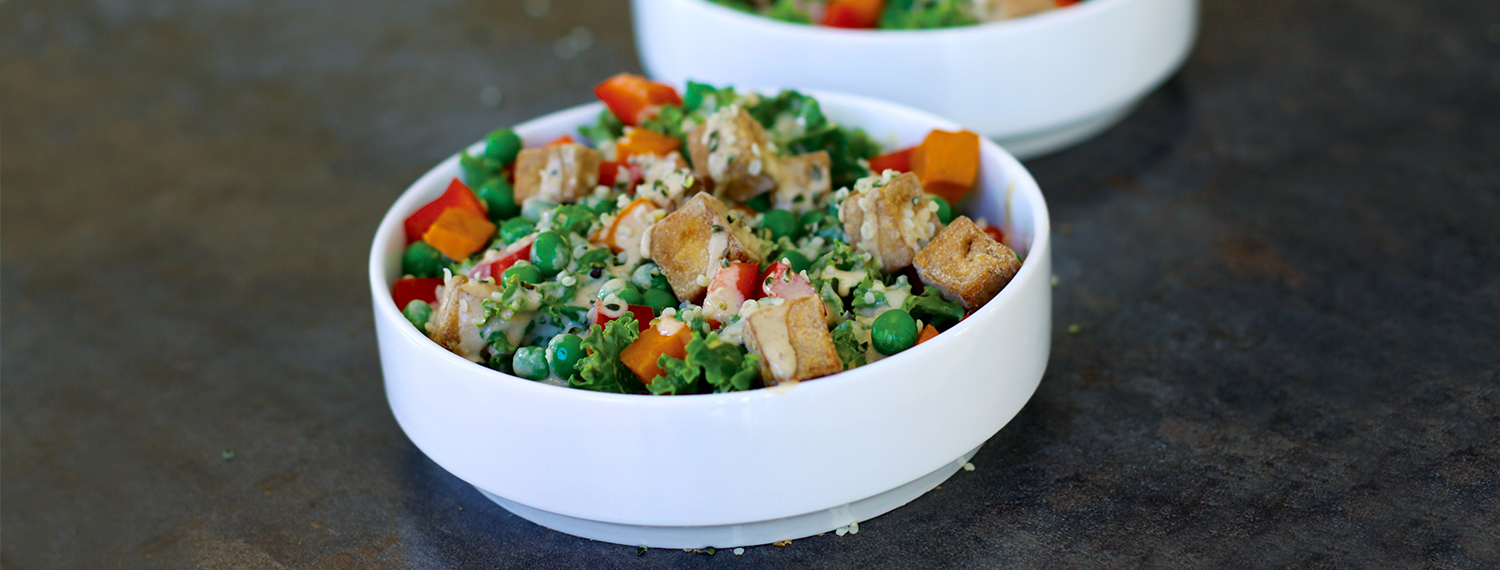When most people think ‘salad,’ they imagine throwing together a few lettuce leaves, a couple of tomatoes and maybe a carrot.
But a salad can (and should) be much more!
Prepared properly, a salad can be a healthful start to your meal, or it may be the entire meal itself.
In either case, your salad should satisfy as well as satiate.
Let’s discover the easy way to build the perfect salad.
Four Foods Chart
The easiest way to prepare a perfect salad is by referring to the Four Foods Chart.
This tool shows you ‘at a glance’ which whole food categories to eat every day, and in what proportions.
The left (green) side of the wheel includes foods that are relatively low in energy density yet are excellent sources of micronutrients and phytochemicals:
- Leafy Vegetables: Spinach, kale, watercress, beet greens, mustard greens, and collard greens.
- Cruciferous Vegetables: Broccoli, kale, cabbage, cauliflower, bok choy, and Brussels sprouts.
- Other Non-Starchy Vegetables: Onions, garlic, bell peppers, eggplant, carrots, and beets.
- Fruits and Berries: Apples, oranges, kiwi, bananas, and berries.
The right side of the wheel (orange and red/pink) covers the higher energy density foods, which contain starches (orange) and fat (red/pink). The four categories of foods nourish the body while keeping you satiated longer:
- Starchy Vegetables: Tapioca, water chestnuts, parsnips, potatoes, sweet potatoes, yams, and butternut squash.
- Whole Grains: Barley, bulgur, corn, oats, quinoa, rice, rye, and wheat.
- Legumes: Chickpeas, black beans, lentils, green beans, green peas, soybeans, and peanuts.
- Nuts and Seeds: Almonds, cashews, pecans, sunflower seeds, hemp seeds, walnut, flaxseed, and chia seeds.
Taken as a whole, the Four Foods Chart gives us a complete picture of what we need to eat to achieve a balanced whole food plant-based diet.
Plus it makes building a perfect salad really simple.
When preparing your salad, just make sure to include whole plant foods from as many of the nine categories as possible.
Keep things varied, colorful, and have fun as you explore different combinations of ingredients.
A Good Example
For a good example of a perfect salad, check out our recipe for Tofu and Kale Salad With Lemon Ginger Tahini Dressing.
The salad combines several of the wheel’s categories:
- Leafy/Cruciferous Vegetable: Kale
- Non-Starchy Vegetable: Red Bell Pepper
- Starchy Vegetable: Sweet Potato
- Legume: Peas, Tofu
- Seed: Hemp Seeds
Some Mistakes to Avoid
Here are some of the common errors people make when creating salads:
1. Not Using Enough Categories
Probably the biggest mistake is that people often only focus on one or two categories of the ‘wheel’ when building their salad.
They might use leafy vegetables such as lettuce combined with a non-starchy vegetable like a carrot. Obviously, there is nothing ‘wrong’ with these categories, but they are not enough on their own. Both are low in energy density, which means the salad will not fill you up and you will likely be hungry an hour later.
A perfect salad will include ingredients from the right side of the wheel too (i.e., starchy vegetables, whole grains, and/or legumes). These foods provide nutrients, and their higher energy density will satiate you.
2. Limited Selection Within a Category
Another common mistake is being too narrow with choices within a category.
Let’s use leafy vegetables as an example. Why stop at using iceberg or romaine lettuce?
How about trying dark leafy greens like spinach, kale or arugula? Or maybe experiment by adding a few cruciferous vegetables like broccoli, cauliflower or even shaved Brussels sprouts?
Expanding to options beyond the ‘standard’ salad choices will provide additional nutrition and also add variety to the flavor and texture of your salad.
3. Unbalanced Energy Density
Energy density measures the amount of energy in a given weight of food.
High-energy-dense foods have many calories for a small weight, while low-energy-dense foods have far fewer calories for the same weight.
You can ‘balance’ the energy density of your salad by mixing low-energy-dense leafy, cruciferous and non-starchy vegetables with high-energy-dense starches, such as whole grains, and legumes, as well as seeds and nuts.
What About the Dressing?
This brings us to the subject of dressings…and with that, oils.
Once you have created the ideal balance of color, nutrients and energy density, it is essential that you keep your salad healthful by avoiding oil-based dressings.
For starters, doing so will dramatically shift the balance of energy density, since oil is one of the most energy-dense foods around.
Equally, oils offer little or no nutritional value; they are highly processed and have been stripped of both fiber and nutrients.
Instead of using oil-based dressings, experiment with oil-free dressing alternatives that are imaginative, nutrient-packed and full of flavor.
To summarize, here are the steps to building your perfect salad:
- Build Your Base: With leafy and cruciferous vegetables.
- Complement With Color: Capture the beauty of the rainbow using non-starchy vegetables and fruit.
- Satiate with Starches: Bolster your salad with starchy vegetables and whole grains.
- Balance With Beans: Mix in a variety of legumes.
- Make It Memorable: Bring in some extras with mushrooms and olives.
- Sprinkle With Seeds (and Nuts): Add crunch and flavor with almonds, cashews, walnuts, flaxseed, chia seeds, and more.
- Dress It Delicately: Finish off with a creative oil-free based dressing.
Have fun building the perfect salad!


